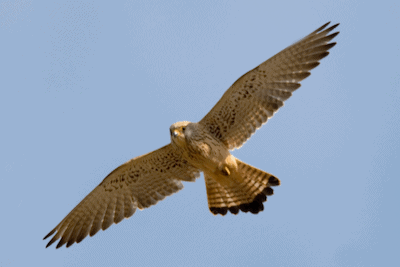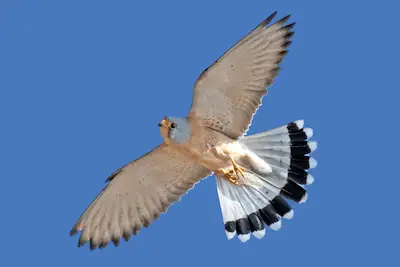Lesser Kestrel
(Falco naumanni)
The Lesser Kestrel is one of the smallest raptors in Europe, and looks very similar to its close cousin the Common Kestrel.
The Lesser Kestrel is perhaps the European raptor that has suffered the most from the changes of agricultural practices over the past century, which have driven it to extinction in central Europe.
As a long distance migrant, the Lesser Kestrel spends the winter in Africa south of the Sahara and Madagascar.

Lesser Kestrels are more social than most other raptor species, and are often found nesting and foraging together in flocks.
Lesser Kestrel facts
The Lesser Kestrel is most often encountered in flocks in southern Europe, and feeds almost exclusively on insects.
Lesser Kestrel size
The Lesser Kestrel is one of the smallest falcon species found in Europe, and looks a lot like a smaller version of the Eurasian Kestrel, both in overall dimensions and colour.
- Wingspan: 57-72 cm
- Length: 29-33 cm
- Weight: 90-210 g
Due to their small size, which is similar to that of a dove, Lesser Kestrels don’t immediately strike the observer as a raptor.
Appearance
The Lesser Kestrel is one of the smallest birds of prey in Europe, being slightly larger than the Merlin (Falco columbarius), and slightly smaller than the Red-footed Falcon (Falco vespertinus).

In terms of proportions and coloration, Lesser Kestrels closely resemble the Common Eurasian Kestrel, though the males have almost no dark spots, making the light grey and rufous parts of their plumage stand out even more.
Sexual dimorphism
Similar to other raptors in Europe, the female Lesser Falcon is considerably larger than the male, although there is an overlap in size between the two genders.
Lifespan
A maximum age of 18 years has been documented in captivity, as well as 16 years in the wild.
Scientific name and taxonomy
The scientific name of the Lesser Kestrel is Falco naumanni. Up to 11 subspecies are thought to occur globally, of which 3 are present in Europe – two on the Canary Islands, and the third throughout the rest of Europe.
The closest relative of the Lesser Kestrel in Europe is the Eurasian Kestrel (Falco tinnunculus), which is considered as its sister species.
Lesser Kestrel distribution
In Europe, the Lesser Kestrel predominantly occurs around the Mediterranean and Black sea. It was previously also found in central Europe, but has been extinct in the northernmost parts of its range for some time now (probably to changes in agricultural practices). Outside of Europe, the Lesser Kestrel occurs in North Africa, and extending eastwards to northern China
Lesser Kestrel habitat
The Lesser Kestrel prefers open landscapes, including arid and semi-arid zones, as well as farmland that is not too intensively cultivated. In addition to open foraging areas, it also requires cliffs or large buildings to provide nesting opportunities.
Lesser Kestrel population size
The total European population of the Lesser Kestrel is estimated to be between 25,000 and 42,000 breeding pairs. The largest part of this occurs in Spain, which has 20,000 pairs. After Spain, the largest populations reside in Turkey (up to 7,000 pairs), Italy (up to 3,900 pairs), and Greece (up to 3,500 pairs).
Lesser Kestrel behavior
The Lesser Kestrel is much more gregarious than most other European raptor species, and is very often found in groups of several birds, both when nesting and when foraging. Even in its wintering range, Lesser Kestrels often occur in flocks.
Feeding and diet
The largest part of the Lesser Kestrel’s diet is composed of insects, which distinguishes it from the Common Eurasian Kestrel, which feeds predominantly on small rodents. In their winter range, Lesser Kestrels often feed on swarming insects, including termites, locusts, and others.
The preferred way of hunting is from a perch, which is very often a power pole or telephone wire. Sometimes also uses hovering as a tactic, but not as often as the Eurasian Kestrel.
Breeding
The Lesser Kestrel breeds in colonies of 10-20 pairs, and uses crevices or holes in cliffs or old buildings. Lesser Kestrel populations have suffered steep declines because modern buildings don’t provide as much opportunity for nesting compared to older ones.
Migration
The Lesser Kestrel is a strict migratory bird that performs a trans-equatorial migration to winter in southern Africa and Madagascar. However, a handful of adult birds spend the winter in the southernmost parts of Spain and Italy.
Its strict migratory pattern is similar to that of the Eurasian Hobby (Falco subbuteo). This correlates well with the fact that both species predominantly feed on insects, which are scarce during winter in their breeding grounds.
Lesser Kestrel conservation status
The Lesser Falcon has seen a precipitous decline in Europe over the past century, in large part due to the shift in agricultural practices towards intense industrial agriculture, which destroys the habitat of its main food source, large insects.
As part of this negative population trend, the Lesser Falcon has become extinct in the northernmost parts of its range in central Europe, where it used to breed in the past.
However, recently the European population seems to have stabilized, especially in Spain, which houses the largest population of Lesser Kestrels. Because of this, BirdLife International has downlisted the Lesser Kestrel from “Vulnerable” to a status of “Least Concern.”
Threats
The main threat to Lesser Kestrels is the intensification of agricultural practices, which has occured throughout most of Europe. Intense modern agriculture creates a monoculture in many cases, and destroys the habitat of many animal species, including large insects, which are the main food source of Lesser Kestrels.
